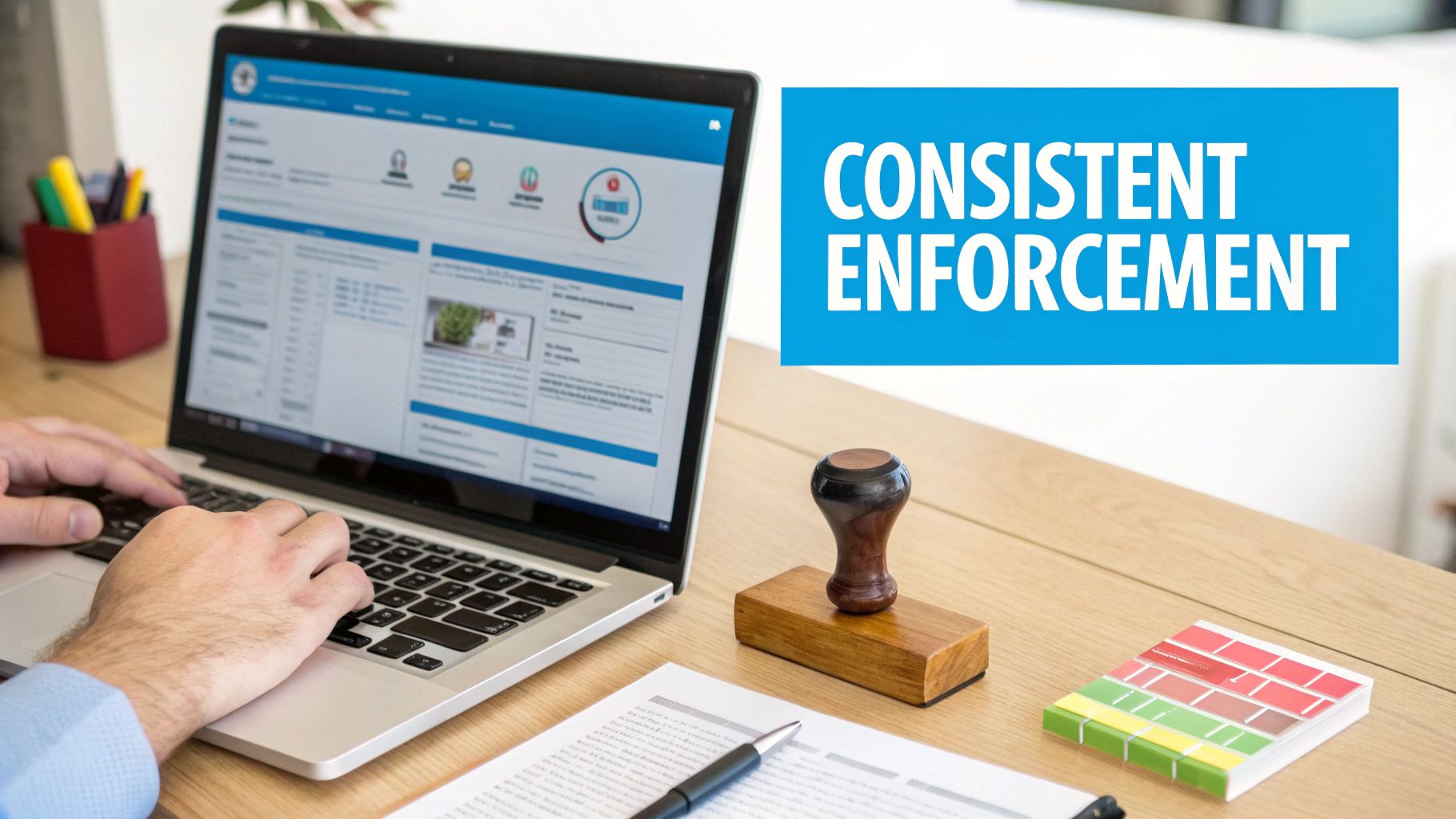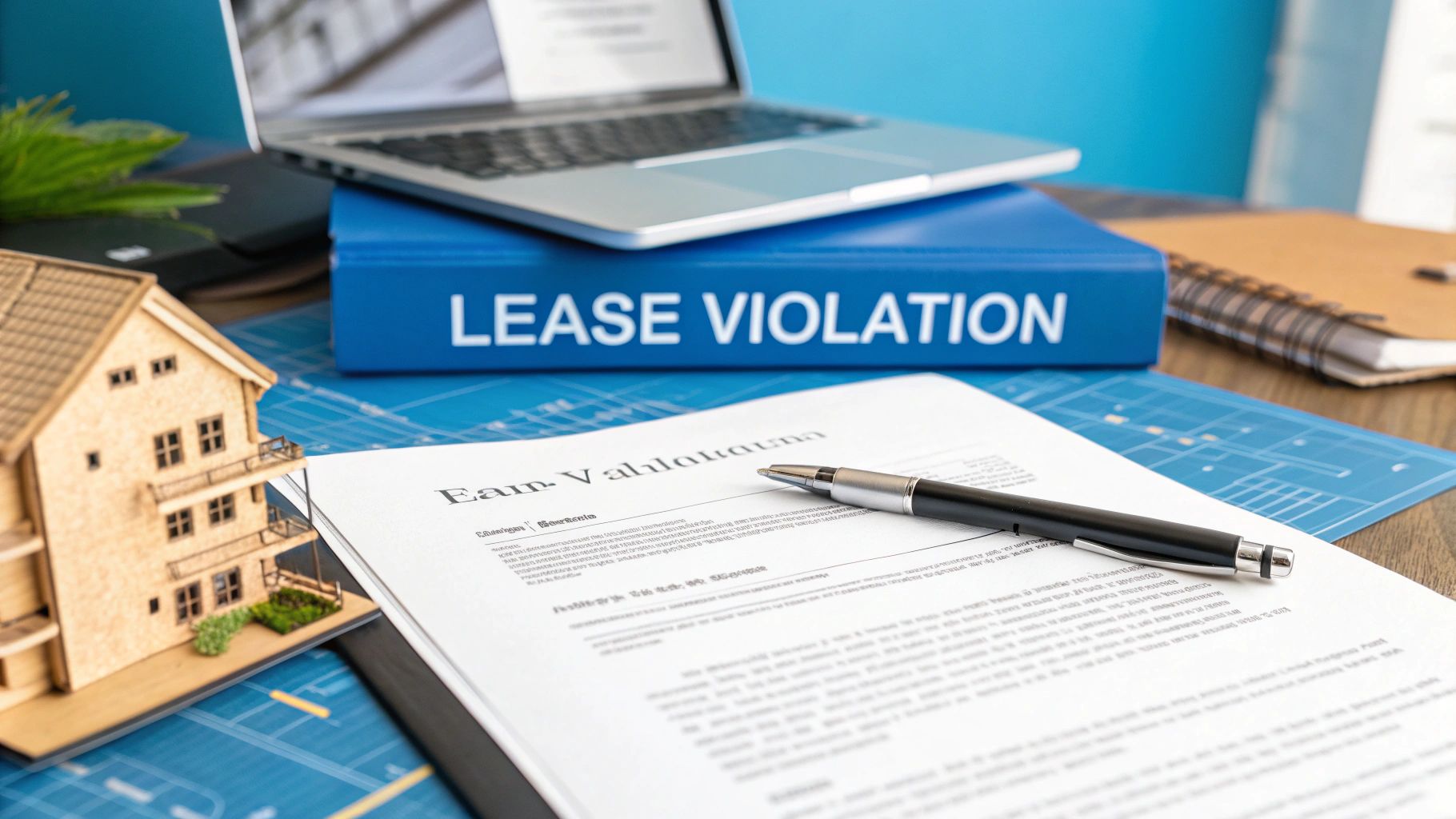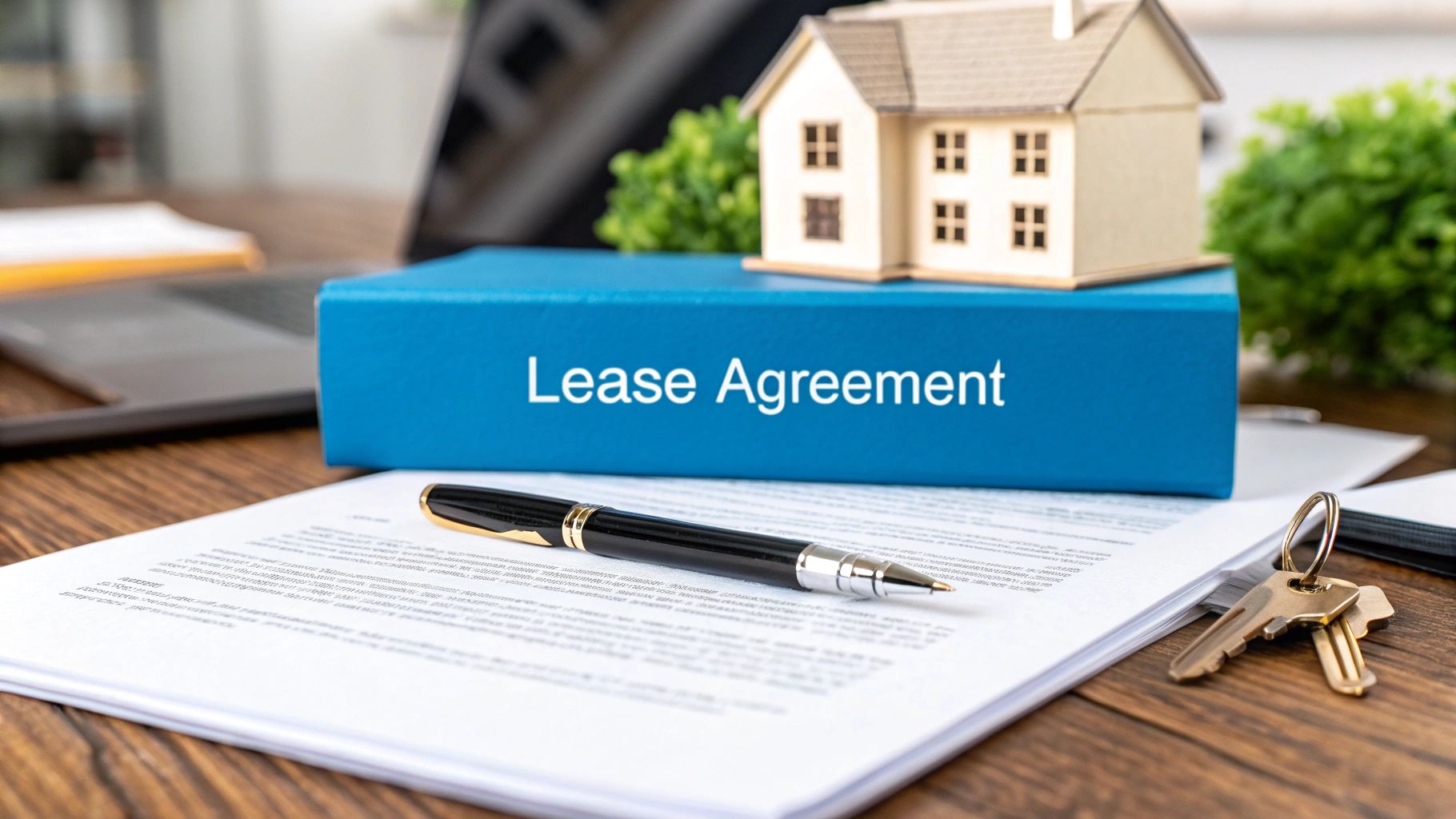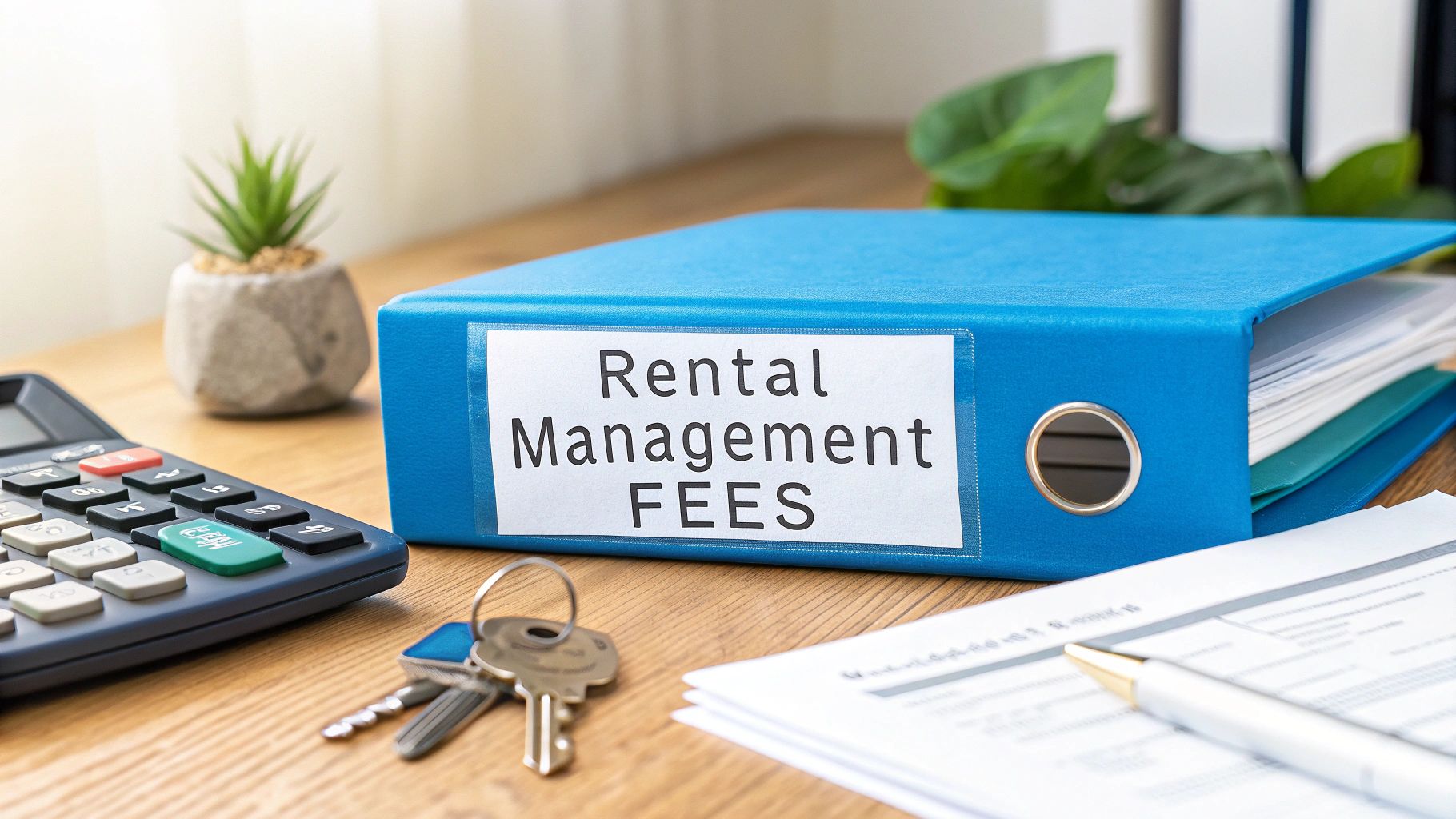When managing hundreds—or even thousands—of rental units, a standardized lease violation notice template isn't just a useful document. It’s a critical component of your operational framework, essential for mitigating risk and ensuring consistency across a distributed portfolio. This template acts as a playbook, guaranteeing every tenant issue is handled with the same professional precision, reducing legal exposure and protecting your revenue.
Why Standardized Notices Are Non-Negotiable at Scale

For property management companies overseeing 1,000 or more units, inconsistency is a direct threat to operational efficiency and the bottom line. Imagine one property manager sending a casual email about an unauthorized pet while another issues a formal notice for the same violation in a different market. This fragmented approach creates a chaotic, legally vulnerable system that is impossible to manage effectively at scale.
A single mishandled lease violation can quickly escalate into costly legal disputes, damage tenant relationships, and consume valuable administrative hours. Without a repeatable process, remote teams are forced to improvise, leading to slow enforcement and, ultimately, longer vacancy periods. This administrative drag directly increases your cost per door and negatively impacts portfolio performance, as every vacant day represents lost revenue.
Protecting Revenue and Minimizing Legal Exposure
The primary function of a standardized notice is to create a predictable, scalable, and legally defensible process. A master lease violation notice template, vetted by legal counsel, ensures that every issue—from late rent to a noise complaint—is addressed with the same legal diligence. This consistency is your strongest defense against claims of discrimination or unfair treatment.
By ensuring every tenant receives the same communication for the same violation, you build an equitable and defensible enforcement process. This systematic approach is crucial for avoiding fair housing complaints, which often arise when tenants perceive that rules are applied inconsistently.
This structured methodology also accelerates resolution. When your team has a clear protocol and a ready-to-use template, they can act immediately. Faster action often leads to faster compliance. If the issue persists, it initiates the legal process more efficiently. Every day saved in this process is revenue protected.
For any large-scale operation, a legally sound notice is fundamental. Below is a breakdown of the key elements every notice must include to be effective and withstand legal scrutiny, particularly when managing a large and dispersed portfolio.
Essential Components of an Effective Lease Violation Notice
Having a template that standardizes these components is non-negotiable. It guarantees that no matter which team member sends the notice, all legal bases are covered consistently across your entire portfolio.
Empowering Remote Teams with Scalable Systems
For property management companies with remote or multi-market teams, standardized templates are even more critical. Your staff, spread across different cities or states, need a centralized playbook to act decisively without direct oversight. A well-designed template system empowers them to handle violations with confidence, knowing they are backed by company policy and legal best practices.
This systemization delivers key operational advantages:
- Uniformity Across the Portfolio: Every notice reflects the same professional standard, reinforcing your brand's credibility.
- Reduced Training Time: New hires can quickly learn one of the most critical aspects of property management.
- Clear Audit Trails: Standardized documents are easily tracked within your property management software, providing a clear history of violations and resolutions.
According to data from the Eviction Lab at Princeton University, landlords file over 3.6 million eviction cases in an average year, a figure underscoring the frequency of tenant disputes. Formal, clear communication is your best tool for resolving issues before they escalate to legal action.
Ultimately, a standardized notice system isn't just about administrative efficiency; it's a strategic imperative that enables growth. It's a foundational element for building an operation that can scale from 1,000 to 10,000 units without being crippled by manual, inconsistent workflows. To learn more about building these kinds of scalable systems, check out our discussion on the future of property management.
Building Your Master Lease Violation Template

Your lease violation notice template should be viewed as a precision tool for risk management, not just a document. For portfolios spanning multiple markets, you need a template that is legally robust in every jurisdiction yet simple enough for any team member to use effectively. It's time to move beyond generic online forms and build a scalable asset that is legally sound and integrated into your operations.
An effective template is a communication system. It ensures every critical detail—from the exact lease clause violated to the specific compliance deadline—is communicated with zero ambiguity. This clarity reduces tenant inquiries, accelerates compliance, and ultimately lowers your operational cost per door.
Crafting the Core Legal Language
This is where expert collaboration is essential. The foundation of your template must be legally unshakeable, so your first step is to engage legal counsel specializing in landlord-tenant law for every state you operate in. Your objective is to create a master document with universal clauses and clearly delineated sections for state-specific requirements.
Ensure these key legal elements are locked down:
- An Irrefutable Violation Description: The language must be factual, objective, and direct. It should empower your team to state the violation and reference the lease directly. For example, "Violation of Lease Agreement, Section 5.2: Unauthorized Pets."
- Crystal-Clear 'Cure or Quit' Phrasing: The notice must explicitly state what the tenant must do to remedy the violation ("the cure") and the exact date for compliance. This timeline is not arbitrary; it must adhere to local statutes, which can range from a 3-day notice for non-payment in one state to a 14-day notice for other issues elsewhere.
- Consequences of Non-Compliance: This section leaves no room for misinterpretation. It must clearly state the consequences of ignoring the notice, typically lease termination and the initiation of formal eviction proceedings. This language establishes firm boundaries and protects your right to escalate.
For property managers handling a high volume of notices, tools like AI legal template generators can help ensure every communication remains consistent and compliant with your master framework.
Structuring for Clarity and Action
A legally perfect notice is ineffective if the tenant cannot understand what is required. The design of your template should guide the recipient's attention to the most important information. Avoid dense paragraphs of legal jargon in favor of a clean, sectioned layout that is easy to scan.
Here’s a structure that promotes clarity and action:
- Header: Your company branding and contact information should be prominent, beneath a bold title such as "Notice of Lease Violation."
- Recipient Info: Clearly list the full names of every tenant on the lease and the complete property address, including the unit number.
- Violation Details: Use a simple table or bullet points to break down the issue. Include "Date of Violation," "Description of Violation," and "Lease Clause Violated."
- Required Action: A bolded section titled "Required Action to Cure Violation" should provide a simple checklist of necessary steps.
- Compliance Deadline: Make this section impossible to miss. Use bold text and unambiguous phrasing: "You must complete these actions by [Date] at 5:00 PM."
- Signature and Date: Provide a space for the property manager’s signature and the date the notice was issued.
Pro Tip: Incorporate a "Proof of Service" section at the bottom of your internal copy. This is where the person delivering the notice records the date, time, and method of delivery (e.g., hand-delivered, certified mail). It is an essential piece of documentation for your records and a critical element of a defensible audit trail.
Sample Phrasing for Common Violations
The true power of a master template lies in having pre-approved, legally-vetted language snippets ready for deployment. This prevents team members from improvising and inadvertently creating legal risk.
Here are a few examples to adapt with your legal team:
- For Unauthorized Occupants: "An individual not listed on the executed lease agreement has been residing at the property for a period exceeding the 14-day guest limit as defined in Section 7.1 of your lease. To cure this violation, the unauthorized individual must vacate the premises immediately."
- For Property Damage: "On [Date], significant damage was observed to the [e.g., drywall in the main living area], which constitutes a violation of Section 8.3 regarding tenant responsibility for property maintenance. To cure, you must arrange for professional repair of the damage by a licensed contractor and provide a receipt by the compliance deadline."
- For Noise Complaints: "We have received multiple, documented complaints of excessive noise from your unit on [Date(s)] during designated quiet hours (10:00 PM - 7:00 AM), in violation of Section 9.5. To cure, you must immediately cease creating noise that disturbs neighbors."
By building a master template with these components, you are creating more than a document. You are building a system that drives consistency, reduces legal exposure, and streamlines a critical—and often stressful—aspect of property management. It transforms a reactive headache into a predictable, efficient workflow.
Fine-Tuning Your Notice for Specific Violations
A solid lease violation template is your starting point, but its true operational value lies in its adaptation. A notice for an unauthorized pet requires different evidence and language than one for a parking violation. You must customize your template to be crystal clear and legally sound, leaving no doubt about the violation and the required remedy.
This doesn't mean reinventing the process each time. A scalable approach involves creating a library of pre-approved, legally-vetted snippets for common issues. Think of them as plug-and-play modules that your team can insert into the master template, ensuring legal consistency while addressing the specifics of each situation.
Unauthorized Pets
This is a frequent issue in rental portfolios. A generic "you have a pet" notice is insufficient and invites disputes. You need to be specific and support your claim with evidence.
Your notice should clearly state:
- The Details: "An unauthorized brown dog, consistent in appearance with a Labrador mix, was observed on the property on [Date] at [Time]."
- The Proof: Reference your documentation. For example, "This was documented with a timestamped photograph taken by our property manager during a routine exterior inspection."
- The Solution: The required action is unambiguous. "The unauthorized animal must be permanently removed from the premises by [Date]."
This level of detail preempts arguments and demonstrates a professional, fact-based approach.
Smoking in a Non-Smoking Unit
This can be more difficult to prove than a pet, which is why your documentation must be meticulous. A claim of smelling smoke is subjective and easily disputed. You must build a stronger, evidence-based case.
Your notice should cover:
- Multiple Data Points: "We have received documented complaints from neighboring residents regarding cigarette smoke emanating from your unit on [Date 1] and [Date 2]. Additionally, our maintenance technician noted a strong smoke odor during a scheduled repair on [Date 3]."
- The Lease Clause: Reference the specific non-smoking addendum signed by the tenant.
- The Fix and the Consequences: "To resolve this violation, you must cease smoking inside the unit immediately. Any further violations may result in charges for smoke remediation and professional deodorizing, as outlined in your lease agreement."
Building a case for smoking violations may involve more than just complaints. Consider witness statements, detailed staff reports, or photos of ashtrays on a balcony if your policy covers the entire property. The key is consistency in documentation and enforcement to remain compliant with fair housing laws.
Parking Violations
In multi-family communities, parking issues can escalate quickly. Prompt and clear notices are crucial for maintaining order among residents.
A parking violation notice must be direct and factual:
- Vehicle Info: "A blue Honda Accord with license plate [Plate Number], registered to your unit, was parked in guest spot #14 for 72 consecutive hours, from [Start Date/Time] to [End Date/Time]."
- The Rule Broken: "This is a direct violation of Section 4.5 of the community rules, which limits guest parking to a 24-hour maximum."
- What Happens Now: "Please move the vehicle to your assigned parking space immediately. Future violations may result in the vehicle being towed at your expense."
Unauthorized Alterations
A common scenario involves a tenant making unapproved "improvements" to the property. This can create significant liability and future maintenance costs. You must address this firmly, outlining both safety and financial implications.
Ensure your notice includes:
- The Specific Alteration: "During a maintenance visit on [Date], it was observed that the master bedroom walls had been painted dark blue without prior written permission."
- The Lease Violation: "This is a violation of Section 6.2 of your lease, which states that no alterations may be made to the property without the landlord's prior written consent."
- How to Fix It (and Who Pays): "To cure this violation, you have two options: a) hire a professional to repaint the walls to their original neutral color by [Date], or b) sign a lease addendum acknowledging full financial responsibility for the cost of repainting upon move-out."
By tailoring your template for these common scenarios, your team can act quickly and confidently. Systemizing the language and evidence for each infraction creates a process that protects your assets, reduces disputes, and maintains smooth operational flow.
Implementing a Scalable Notice Delivery System
Creating a robust lease violation notice template is foundational, but it's only half the process. For property managers overseeing large portfolios, the operational challenge lies in delivering, tracking, and documenting notices flawlessly across hundreds or thousands of units.
The method of service is what separates a smooth, defensible action from a costly legal challenge. Relying on inconsistent or ad-hoc delivery methods is an open invitation for disputes and delays that can negatively impact revenue.
At scale, your system must create an undeniable, auditable trail for every notice. This is about operational efficiency as much as legal compliance. Every failed delivery or disputed receipt adds administrative hours and can extend vacancy periods, directly impacting your bottom line.
Choosing Your Delivery Method
For enterprise-level operations, the key criteria are reliability, legal validity, and scalability. While local laws dictate specific requirements, most large-scale managers rely on a few core options.
- Certified Mail with Return Receipt: This has long been the gold standard for creating a legal paper trail. The signed receipt card is powerful proof of delivery. However, it is slow and administratively burdensome, making it difficult to manage at scale without automation.
- Hand-Delivery with a Witness: Direct delivery is effective, especially with field staff. A signed affidavit of service from a witness strengthens your case. The challenge is the logistical complexity and cost per door across a distributed portfolio.
- Posting and Mailing ("Nail and Mail"): In many jurisdictions, if a tenant is unavailable, you can post the notice on their door and send a copy via mail. This dual approach is often legally sufficient but requires meticulous documentation, including timestamped photos of the posted notice.
For critical communications, proper delivery is non-negotiable. It's always a best practice to stay current on legal requirements by understanding how to send a certified letter and other service methods.
This flow chart illustrates how a master template is customized, documented, and delivered as part of a systematic process.

As shown, documentation is not an afterthought. It is the final, crucial step that ensures every action taken is recorded and legally defensible.
Notice Delivery Method Comparison for Large Portfolios
Choosing the right delivery method for a large, distributed portfolio requires balancing proof of service, speed, and cost. Here’s a breakdown to evaluate the options at scale.
While each method has its place, integrating delivery into your technology stack is the key to achieving true scalability and ensuring consistency.
Integrating Delivery into Your PropTech Stack
The most efficient way to manage notice delivery at scale is to integrate it directly into your property management software (PMS). A robust system transforms this manual, error-prone task into an automated, trackable workflow.
A truly scalable system doesn't just send a notice; it creates a complete communication log. It should automatically track delivery status, send deadline reminders to both the tenant and your team, and flag accounts for escalation if the compliance date passes. This turns a reactive process into a proactive one.
This integration is your best defense against ambiguity. Shockingly, researchers estimate that forced moves from informal evictions are more than five times as common as formal ones. This data highlights the critical need for clear, documented processes that protect both you and your tenants from "he said, she said" disputes.
By connecting your notice system to your PMS, you create a single source of truth. Every communication is logged directly in the tenant's record, building an unassailable case file that holds up in court and demonstrates fair, consistent processes across your entire portfolio. To see how modern platforms drive this kind of efficiency, it’s worth exploring some new tools for leasing automation.
Staying Compliant with Fair Housing Laws
When managing a large, distributed portfolio, the risk of a fair housing complaint is magnified with every unit. The fastest way to attract a discrimination claim is through inconsistent application of rules, which can turn a simple lease violation into a significant legal and financial liability.
Building an equitable and compliant enforcement process is non-negotiable. This extends beyond having a good lease violation notice template; it requires a rigid operational framework that dictates how and when those notices are used. The goal is a system where every tenant is treated uniformly, and every action is based on an objective violation of the lease, not subjective judgment.
Documenting Objective Criteria for Enforcement
The bedrock of fair housing compliance is consistency. To achieve this at scale, you must define and document objective criteria for issuing notices. This means creating a clear, internal policy that specifies the exact triggers for a notice for each type of infraction.
Your framework should include:
- Violation Tiers: Categorize violations by severity. A minor infraction, like leaving a trash can out, might receive a documented warning for a first offense. In contrast, non-payment of rent should trigger an immediate formal notice.
- Evidence Standards: Define the required proof for each violation type. For a noise complaint, you might require two documented complaints from different neighbors within 30 days. For an unauthorized pet, the standard could be a timestamped photo from a field agent.
- Mandatory Timelines: Standardize your "cure or quit" timelines based on state law and the violation type. This ensures no tenant receives more or less time than another for the same issue.
This approach removes individual discretion from the process, which is a common source of discrimination claims. When your team follows a clear, company-wide playbook, every enforcement action becomes a defensible business decision backed by documented policy.
Training and Auditing for Scalable Compliance
A policy is only as effective as its implementation. For remote or multi-market teams, ongoing training is essential to ensure everyone understands the nuances of fair housing laws and the importance of impartiality. This training should cover unconscious bias and focus on fact-based, objective enforcement.
Rental-related issues are a significant source of legal challenges. In 2021, there were 25,501 rental-related housing discrimination complaints filed, accounting for 81.69% of all complaints. This statistic underscores the critical importance for property managers to ensure their enforcement processes are bulletproof.
To verify that your policies are being followed, conduct regular internal audits of enforcement actions. Pull a random sample of lease violation notices issued across your portfolio each quarter and review them for consistency.
Ask these critical questions:
- Was the correct, standardized template used for similar violations?
- Was the required evidence attached to the tenant's record in the PMS?
- Were the cure deadlines consistent and legally compliant for that jurisdiction?
These audits provide invaluable operational insights and demonstrate a proactive commitment to fair housing. By building a system rooted in objective criteria, continuous training, and regular audits, you create a scalable process that mitigates legal risk and reinforces a professional, equitable standard across your entire portfolio.
For more strategies on building positive and legally compliant interactions, explore our guide on communication tips for the tenant-manager relationship.
Common Questions About Lease Violation Notices
Even with the most robust systems, questions arise. When managing a large portfolio, you need quick, standardized answers to maintain operational momentum and ensure compliance. Here are some of the most common questions about handling lease violation notices at scale.
Cure or Quit vs. Unconditional Quit: What's the Difference?
Understanding the appropriate use of each notice is a critical component of risk management.
A "Cure or Quit" notice is your standard operational tool. It provides the tenant with a clear, legally mandated window to resolve the issue—such as removing an unauthorized pet within three days or paying overdue rent. This is the first formal step for most common violations. The objective is to achieve compliance and preserve the tenancy, thereby avoiding turnover costs and legal fees.
An "Unconditional Quit" notice is reserved for severe violations. This is used for issues like illegal activity on the property or significant, intentional property damage. This notice demands the tenant vacate the premises without an opportunity to cure the violation. For a large portfolio, this should be an extremely rare action, always taken in consultation with legal counsel, as it leads directly to formal eviction proceedings.
How Do I Keep Notices Consistent Across Different States?
This is a primary challenge for multi-market operations, as landlord-tenant laws vary significantly by state. The key is to build a process that removes guesswork for your teams.
A simple, effective framework includes:
- Centralize Your Legal Review: Have legal counsel create state-specific addendums or versions of your master lease violation template. They will ensure compliance with local notice periods, delivery methods, and required legal language.
- Bake It Into Your Software: Integrate the approved templates directly into your property management software. Use dropdowns and required fields to ensure staff can only select the correct, compliant notice for their specific location.
- Automate and Audit: The system should auto-populate key details to reduce human error. Regularly audit sent notices to ensure adherence to the standardized process.
This system ensures that whether the notice is for a property in Texas or Florida, it meets both your company standards and local laws.
Should I Send a Warning Before a Formal Notice?
This is a strategic decision that should be codified in your company's operational playbook to ensure consistency. The answer depends on the severity of the violation.
For minor, first-time infractions—such as improper trash disposal or leaving a bicycle in a common area—an informal warning is often appropriate. It serves as a customer-friendly first step that can resolve the issue without escalating tensions.
However, for significant issues like non-payment of rent, an unauthorized occupant, or property damage, a formal notice should be issued immediately. This action officially starts the legal clock and protects your rights as the landlord.
Your internal policy is your best defense against claims of disparate treatment. Clearly define which violations receive an informal warning and which require an immediate formal notice. A consistent, structured approach is crucial for treating all tenants fairly and mitigating potential fair housing claims.
What if the Tenant Won't Accept the Notice?
A tenant's refusal to answer the door or sign for a certified letter does not invalidate the notice. As long as you have properly "served" the notice according to state law, your legal obligations have been met. This is why a documented, iron-clad delivery process is critical.
Their refusal to accept service is not a viable legal defense.
Your proof is in your documentation. Using methods like certified mail (refusal to sign is still documented), "post and mail" (supported by a timestamped photo), or a professional process server creates an unimpeachable legal record. For any large-scale operation, using a documented, multi-step delivery method for every notice is the best practice to preempt any claim that they "never received it."
Managing lease violations across a large portfolio demands precision, consistency, and scalability. Showdigs offers an AI-backed leasing automation platform that streamlines your operations from initial lead to signed lease. Let our system handle repetitive tasks so your team can focus on high-value activities. Reduce vacancy days and enhance efficiency across your entire portfolio. Discover how Showdigs can transform your leasing process today.






